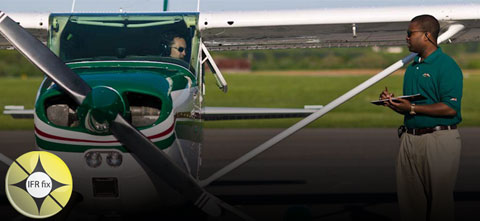
An instrument rating opens doors, so please keep looking out the window.
Flying IFR, it’s easy to forget the days of begging access to surface-based controlled airspace, or knocking on air traffic control’s door for workload-permitting services, feeling like an uninvited guest at a party.
Now you are the workload. You may not always get the routing you want—but you’ll get something.
With privilege comes obligation. But when IFR and VFR worlds collide, instrument pilots whose pride of place has gone awry have been known to evoke the ire of others. Cleared for an approach to a nontowered airport on a VFR day, an IFR aircraft barrels down final to a landing, scattering the local traffic.
That brand of complacency would be risky in marginal conditions. The owner of a no-radio Champ may be quite comfortable shooting touch-and-goes beneath an 800-foot ceiling in a mile’s visibility, and won’t hear you report inbound on your GPS approach.
A major upside to your instrument rating is that it can provide safe passage through complex airspace. An IFR clearance removes most worries about airspace incursions or tangling with temporary flight restrictions, provided, of course, that you fly it properly.
The instrument rating is your de-facto entree to flying aircraft capable of operating in Class A airspace.
There’s also a good long-term return on an instrument rating because it provides upward mobility by serving as a prerequisite to advanced certification goals.
Looking for work? A noninstrument-rated commercial pilot in the airplane category faces a significant limitation: “The carriage of passengers for hire in (airplanes) (powered-lifts) on cross-country flights in excess of 50 nautical miles or at night is prohibited.”
Remove that restriction as provided and you satisfy an eligibility requirement for the airline transport pilot certificate.
Flight instructor applicants in airplanes, other than light sport, must have “an instrument rating or privileges” on their pilot certificates. That’s logical considering that those instructors teach primary flight students basic flight by reference to instruments (and should give those trainees a stern and cogent lecture about why they should never put themselves in a position to have to use it).
Savor your privileges, but keep them fresh. The IFR realm is evolving fast, and pilots with access to “the system” must keep pace.
Earning an instrument rating is guaranteed to be one of the most challenging, rewarding, and fun projects a pilot takes on during a lifetime in aviation. Each week, this series looks at the IFR experience from a new perspective. Catch up on what you may have missed in the IFR Fix archive.



